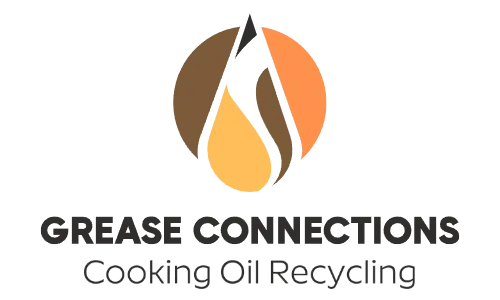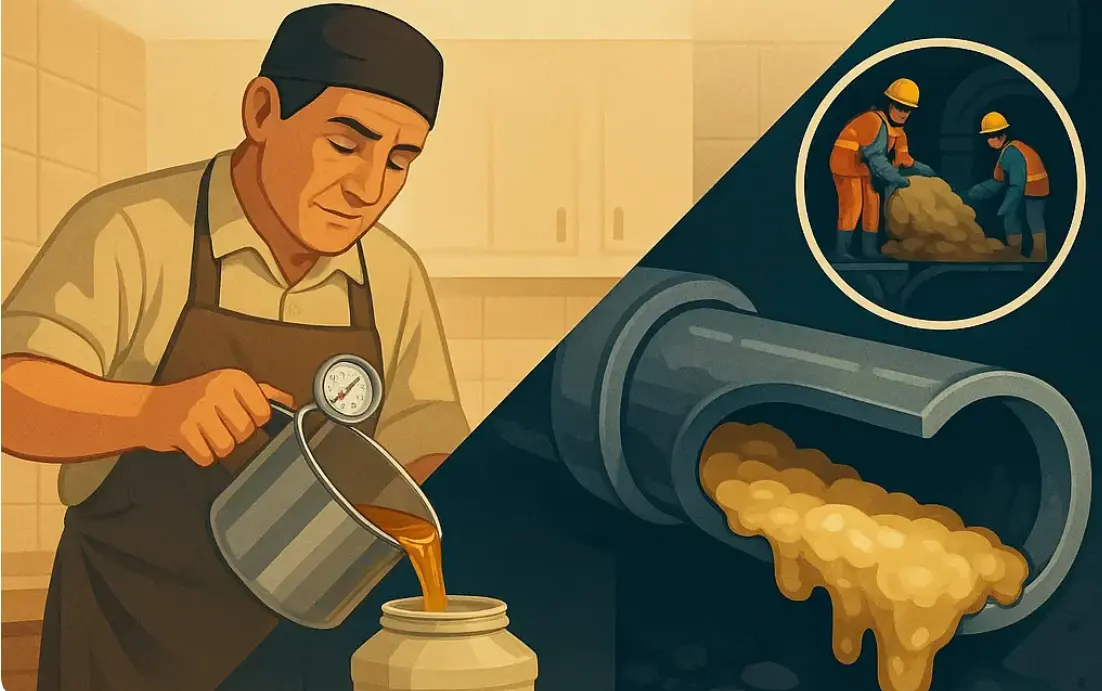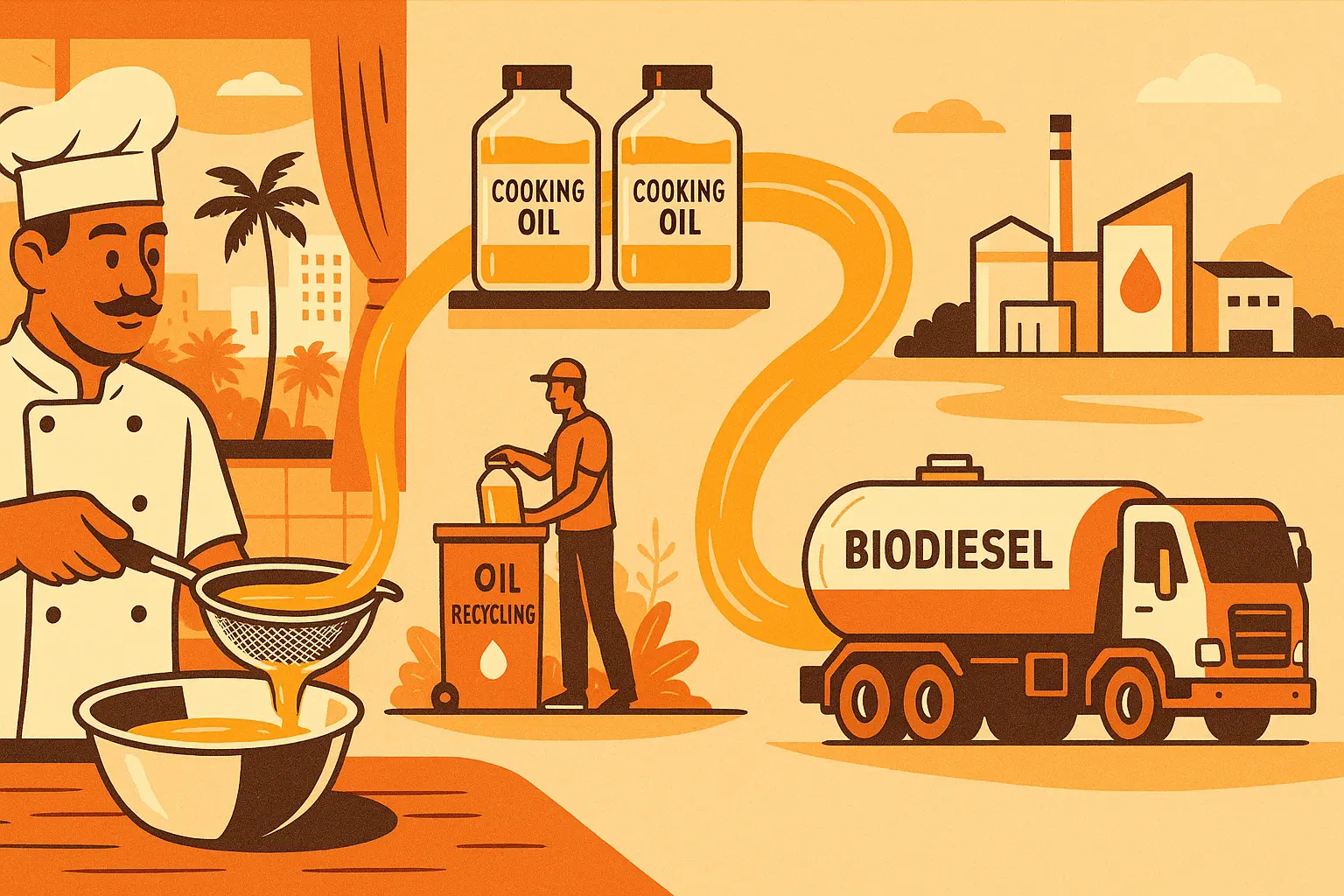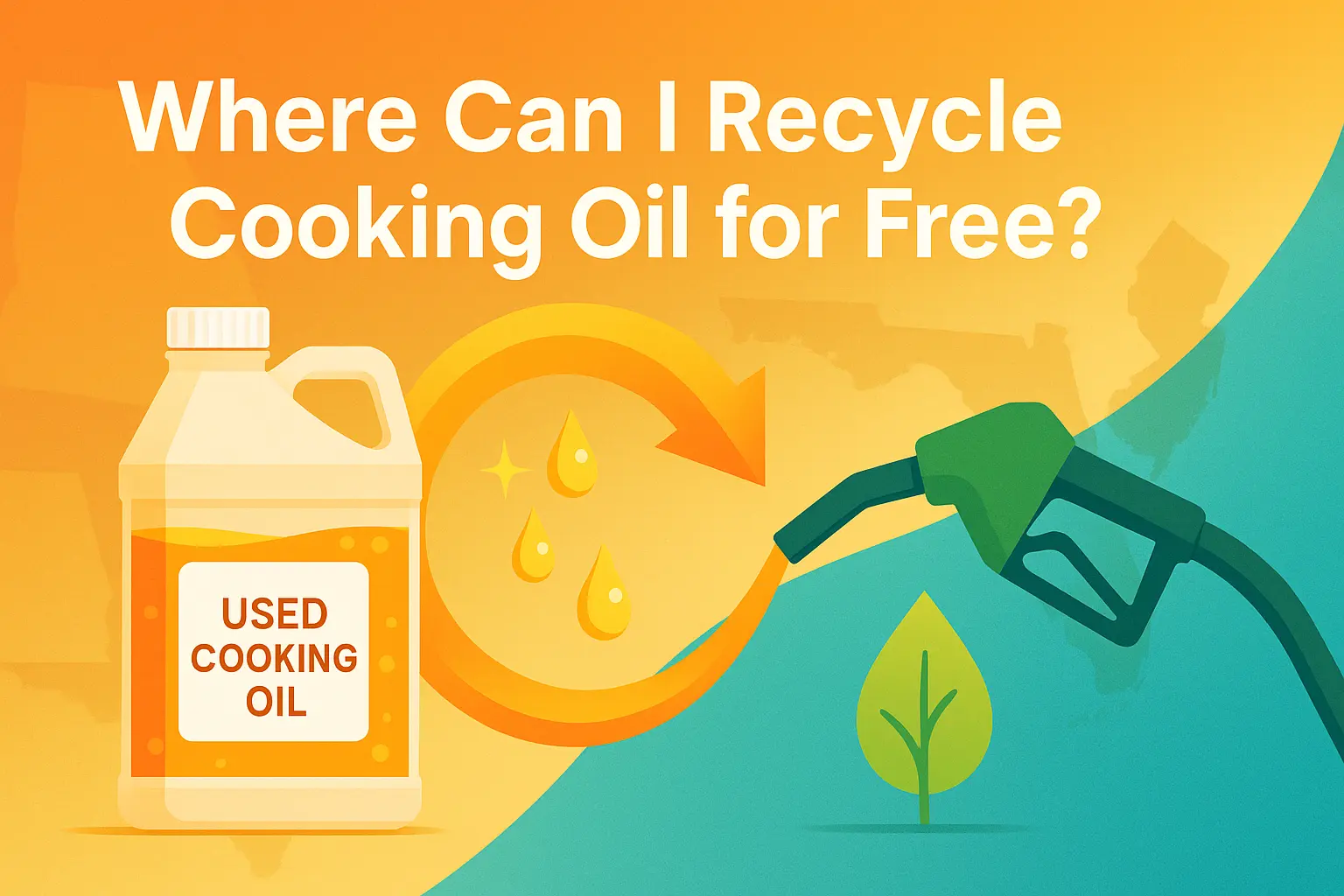The last hush of dinner service lingers in the air. A stainless pot glistens with used cooking oil, still whispering at 350 °F as the burners click off. You catch yourself glancing at the sink—then remembering the time your neighbor called a plumber for a midnight backup that cost nearly $500. That story is more common than you think: professional drain clearing typically runs $300–$7001, and hydro-jetting deeper blockages can climb higher.
This guide leads you from that anxious moment to a confident solution, linking everyday kitchen practice to solid environmental science. Along the way you will learn precisely why oil behaves the way it does, how to cool it to the safe sweet spot of 120 °F / 49 °C, and where to turn a waste product into renewable fuel. Whether you cook a few tempura nights a year or run a 24-hour diner, the journey ahead will spare your pipes, safeguard rivers, and even feed the biodiesel economy. Let’s begin by understanding the hidden price of an impulsive pour.
Why Not to Pour Oil Down Drains

Oil may look slick and harmless, but as it cools it congeals, shrinking the diameter of household piping much like cholesterol narrows an artery. Clearing a single kitchen line averages $300–$7002, and if the clog reaches the main, costs spiral toward four figures. Municipalities face an even bigger bill: Thames Water spends £18 million a year breaking up huge “fatbergs”3 in London’s sewers.
The environment pays, too. The U.S. EPA notes that spilled oil quickly forms surface films that suffocate aquatic life and disrupt entire food webs4. Once oil escapes household plumbing, cleanup shifts to public utilities—costs inevitably folded back into water rates. In short, pouring oil away solves nothing; it simply hands the problem (and the invoice) to someone else.
Cooling and Storing Used Oil Safely
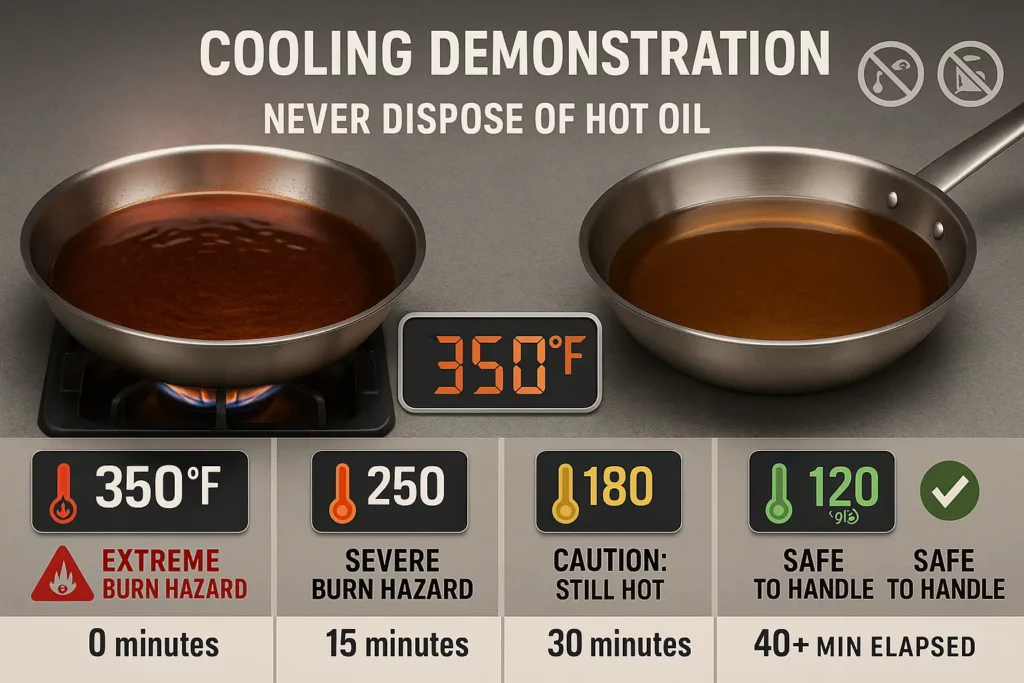
Picture a cook named Mara who fries chicken every Sunday. Her rule of thumb is to kill the flame, set a timer for 40 minutes, and aim for 120 °F before moving the pot. That target temperature keeps plastic from warping and protects skin from steam bursts. Once the timer beeps, she strains the oil through a coffee-filter-lined sieve. Straining removes lingering crumbs, which, if left behind, accelerate rancidity and produce off-flavors by oxidizing in storage.
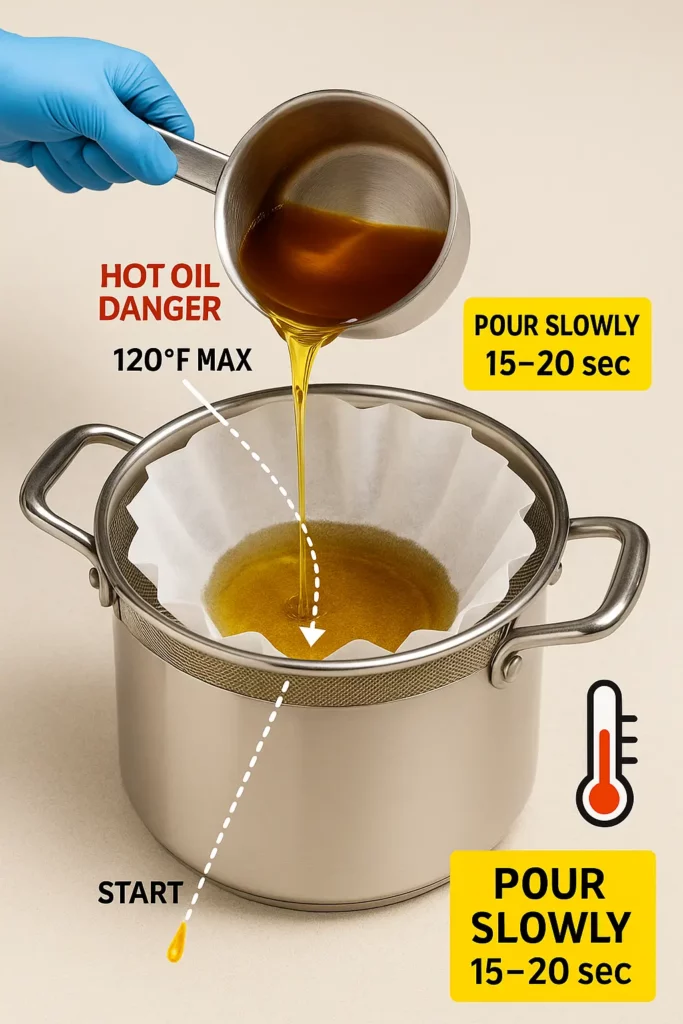
Mara labels each container “Chicken Fry #1 – April 7” and stores it in a cool cupboard. She chooses the vessel based on how long she plans to keep it:
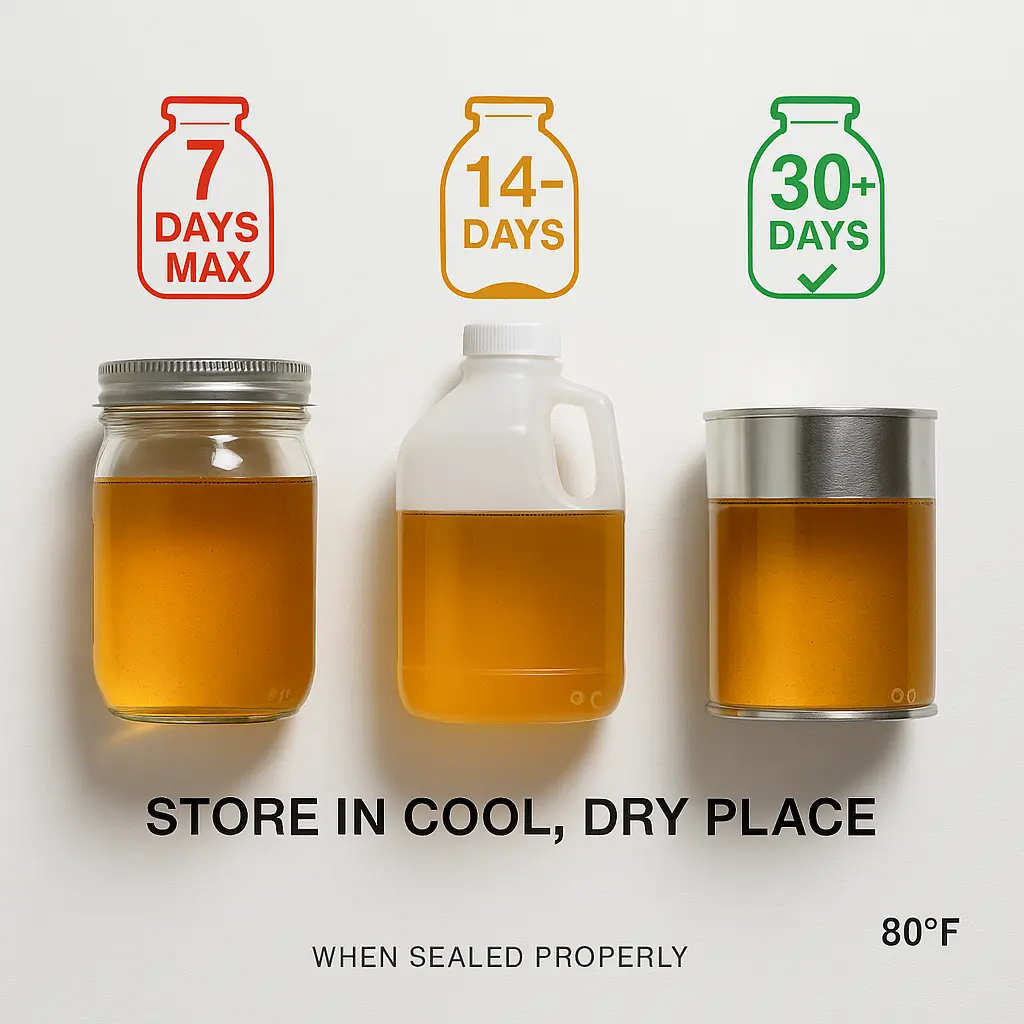
| Container | Pros | Cons | Safe Storage Limit | Why It Matters |
|---|---|---|---|---|
| Glass jar | Non-reactive, flavor neutral | Breakable | 6 months | Ideal for cooks who reuse oil in pastries where taste purity counts |
| HDPE plastic jug | Light, often on hand | Warps above 120 °F | 3 months | Good for frequent fryers who cycle oil quickly |
| Metal coffee can | Durable, freezer-ready | May rust outdoors | 6 months | Perfect for the freezing method (see Section 4) |
Never add water to hot oil—steam can erupt like a geyser. A kitchen thermometer and a little patience avert that hazard.
Smoke-point science helps Mara decide when to toss oil. She knows her peanut oil is healthy above 410 °F, but once it starts smoking below 370 °F, degradation has set in and it’s time for disposal5.
Household Disposal Methods
The Container Method (up to 2 cups)
After cooling and straining, pour oil through a funnel into a screw-top jug. Tighten the lid and set the jug out with the weekly trash. This approach is quick and uses supplies already in the pantry. Downsides? Jugs add weight to the landfill and, if overfilled, may leak on summer pickup days.
Solidifying with Absorbents (2–6 cups)
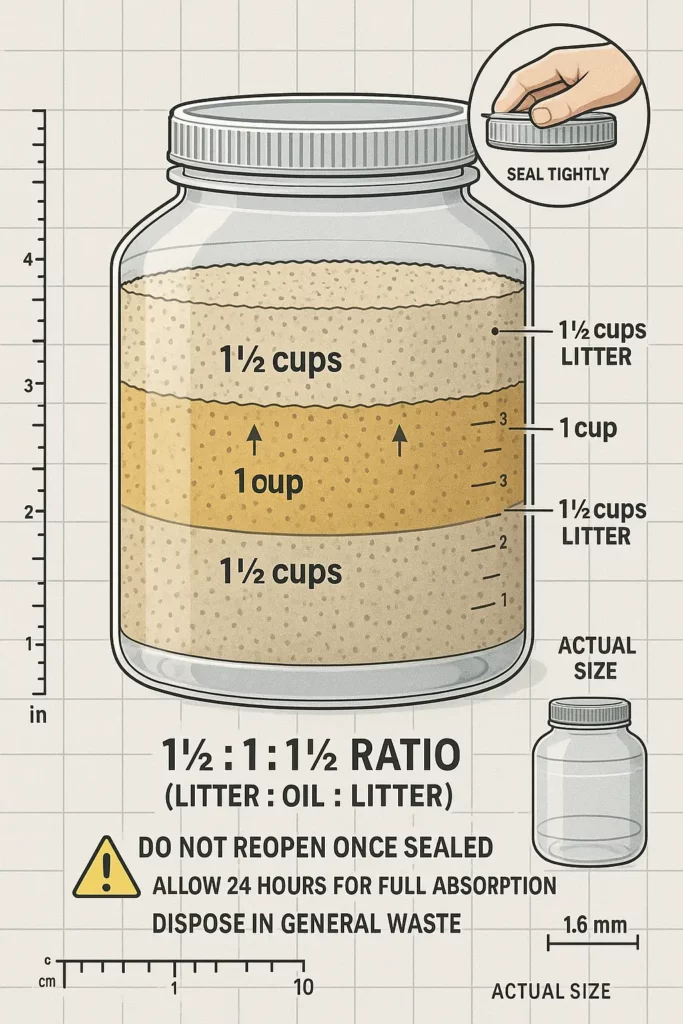
When Mara hosts a fish-and-chips night, she collects about four cups of oil. She lines a discardable tub with kitty litter and follows the 1 ½ cups litter per cup of oil ratio. The mixture thickens into a gel she can dispose of with confidence. The extra absorbent prevents leaks, especially helpful if her city hauls trash long distances over bumpy roads.
Freezing Method (over 6 cups)
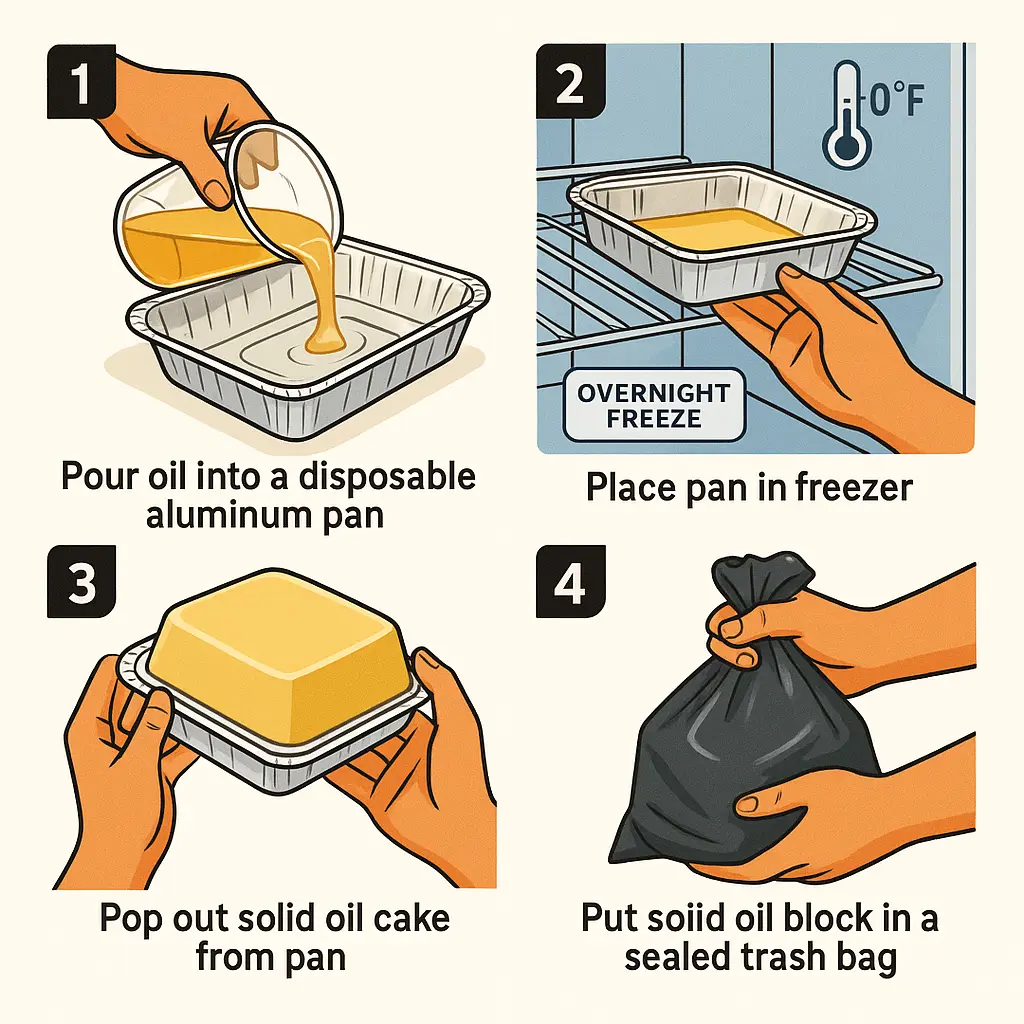
Occasional large-batch fryers—think Thanksgiving turkeys—prefer freezing. They pour cooled oil into a shallow pan, slide it into the freezer overnight, and pop out a tidy block the next morning. In winter climates where outdoor bins stay below 32 °F, the oil remains solid until pickup, eliminating spill risk.
Each technique turns a potential hazard into a manageable task; the key is matching volume to method.
Recycling and Collection Options
Recycling closes the loop, transforming waste into low-carbon fuel. One gallon of filtered oil yields roughly an equal amount of biodiesel; small-scale producers report conversion rates just shy of one-to-one6. That biodiesel can reduce life-cycle CO₂ emissions by up to 75 % compared with petroleum diesel, according to NREL life-cycle models7.
Finding a drop-off site is easier than most cooks expect. City sanitation pages list household haz-waste depots, while some hardware chains accept sealed jugs at the customer-service counter. Scouts and neighborhood associations often host holiday drives, aiming to intercept turkey-fryer grease before it clogs mains. Before you load the car, double-check that your oil is cool (below 100 °F), strained, and clearly labeled; these steps protect recycling equipment from water flashes and food particles.
Why this matters: clean oil fetches a better market price for recyclers, keeping community programs solvent and expanding biodiesel supplies.
Commercial Kitchen Solutions
At scale, manual jugs won’t cut it. A mid-size diner producing 50 gallons a week installs a lockable 120-gallon tank in the alley. Licensed haulers connect hose fittings, pump the oil out, and leave a digital manifest—paperwork required under U.S. EPA 40 CFR Part 279.8 Grease traps inside the restaurant intercept fats before wastewater hits city lines; health codes mandate skimming hydromechanical models at 25 % solids or pumping gravity units every 90 days.
Local clean-fuel incentives sweeten the deal. Some states pay $0.15–$0.25 per gallon for verified loads shipped to biodiesel refineries, turning a waste stream into a line-item credit.
Regional & International Variations
Disposal rules shift with geography. Apartment dwellers in Paris drop sealed bottles into yellow recycling bins next to glass; rural U.S. homeowners, by contrast, may haul oil to county extension depots. To pinpoint your obligations, follow this four-step compass:
- Search “Your-City FOG ordinance.”
- Note household volume limits and container bans (some cities forbid glass).
- Confirm whether curbside pickup is available or drop-off is required.
- Schedule action before holiday rush hours, when depots can close early.
Urban high-rises with elevators often favor the freezing method; farming communities, where septic systems dominate, lean on solidifying small amounts and hiring haulers for bulk.
Specialized Oil Types
Not all oils behave the same. Coconut oil solidifies around 76 °F / 24 °C, so you can scrape small amounts into the compost (under a tablespoon) without litter. Olive oil clouds near refrigerator temps and may smell earthy long before it smokes; discard if it develops a bitter aroma below 374 °F9. Rendered animal fats harden at room temperature—wrap them in newspaper and bin them unless you plan to make soap. When working with blended fry oils, always defer to the lowest smoke-point component to decide reuse versus disposal.
Comprehensive FAQ
I spilled oily dishwater—can I dump it?
Skim the surface oil, strain remaining water through coffee grounds, then flush with hot water and soap. This captures grease before it coats pipes.
How many fries before oil is “done”?
If the smoke point drops 40 °F below its original value or the oil smells acrid, it has oxidized; dispose of it.
Is composting okay?
Tiny drizzles help feed microbes, but more than a teaspoon per square foot slows decomposition and attracts rodents.
Accidentally poured oil down the drain—now what?
Boil a kettle, add a tablespoon of dish soap, and flush for five minutes. If the sink still gurgles, call a plumber to prevent a bigger clog.
Green absorbents?
Spent espresso grounds and shredded corrugated cardboard bind oil well and upcycle kitchen waste.
Outdoor dumping in a flower bed?
It forms a water-repellent layer that suffocates soil microbes—avoid it.
Deep fryer care?
Drain at 150 °F, filter, then choose a disposal route based on volume chart in Section 4.
Holiday cooking oil overload?
Stock labeled jugs before the feast; many depots close for long weekends.
Tiny apartment?
Freeze oil in a quart-size zip bag, then discard flat and leak-proof on trash day.
Conclusion & Key Takeaways
Proper cooking oil disposal isn’t an afterthought; it’s the final step of every fry session. Cool to 120 °F, strain out crumbs, and pick a method that fits your volume—container, solidify, freeze, or better yet, recycle. Cities, wildlife, and even your wallet benefit: biodiesel programs cut CO₂ by roughly 75 %, and avoiding clogs saves hundreds on plumbing. Regulations differ, but the science stays the same: oil and water never mix. Follow these guidelines and join a community of cooks who keep kitchens humming, sewers clear, and rivers alive.
References:
- Carter’s My Plumber, “What is the Average Drain Cleaning Cost? (2025 Update)” (Jan 3 2024). https://www.cartersmyplumber.com/drain-cleaning-cost/ Carter’s My Plumber ↩︎
- Carter’s My Plumber, “What is the Average Drain Cleaning Cost? (2025 Update)” (Jan 3 2024). https://www.cartersmyplumber.com/drain-cleaning-cost/ Carter’s My Plumber ↩︎
- Lucy Campbell, “Workers clear ‘huge, disgusting’ fatberg from London sewer,” The Guardian (Feb 19 2021). https://www.theguardian.com/environment/2021/feb/19/workers-clear-huge-disgusting-fatberg-from-london-sewer The Guardian ↩︎
- U.S. Environmental Protection Agency, Understanding Oil Spills and Oil Spill Response (EPA 540-K-99-007, Dec 1999), p. 1. https://www.epa.gov/sites/default/files/2018-01/documents/ospguide99.pdf US EPA ↩︎
- Wikipedia, “Template: Smoke point of cooking oils,” last modified 2025. https://en.wikipedia.org/wiki/Template:Smoke_point_of_cooking_oils Wikipedia ↩︎
- Penn State Extension, Biodiesel Safety and Best Management Practices for Small-Scale Producers (handbook, 2007): “Each finished gallon of biodiesel requires slightly over one gallon of filtered used cooking oil.” https://www.canr.msu.edu/uploads/files/Fuels/Biodiesel%20Safety%20BMPs%20for%20Small%20Scale%20Use%20Production.pdf Agri College ↩︎
- National Renewable Energy Laboratory (NREL), Biodiesel Blends – Clean Cities Fact Sheet (NREL/FS-540-37136, 2004): “B100 from soybean oil reduces life-cycle CO₂ emissions by 78 %.” https://www.nrel.gov/docs/fy05osti/37136.pdf NREL ↩︎
- U.S. Environmental Protection Agency, “Nonpoint Source Pollution Awareness: Darby Duck, the Aquatic Crusader.” Polluted Runoff: Nonpoint Source (NPS) Pollution (accessed May 6 2025). https://www.epa.gov/nps/nonpoint-source-pollution-awareness-darby-duck-aquatic-crusader ↩︎
- Wikipedia, “Template : Smoke point of cooking oils,” last edited April 29 2025. https://en.wikipedia.org/wiki/Template:Smoke_point_of_cooking_oils ↩︎
